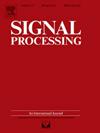Distributed heterogenous multi-sensor fusion based on labeled random finite set for multi-target state estimation using information geometry
IF 3.4
2区 工程技术
Q2 ENGINEERING, ELECTRICAL & ELECTRONIC
引用次数: 0
Abstract
This paper considers the challenging problem of heterogenous multi-sensor fusion using information geometry theory. A novel distributed heterogenous fusion method with labeled random finite set (RFS) multi-target densities is proposed to address multi-sensor multi-target tracking problem. The Fisher information distance (FID) is used to characterize the information acquisition and sensing capability of distributed sensor nodes by analyzing measurement model of sensor nodes via geodesic computation on statistical manifold. A scalar fusion weight is assigned to each local multi-target density in order to characterize its relative information confidence under the different architecture of sensor nodes. The fusion weights are adjusted according to the contribution of each sensor node to global multi-target density. Thus, the proposed distributed heterogenous fusion serves as an adaptive algorithm for multi-sensor multi-target tracking within the monitored area. Aiming to achieve multi-target tracking under the limited sensing capabilities of sensor nodes, we firstly formulate the general framework of distributed heterogenous fusion strategies based on sensor information accumulation. Secondly, we present both numerical and approximate solutions to computing the geodesic on the manifold for FID calculations, furtherly for determining locally tailored fusion weights for different sensor nodes. Finally, we present several simulation results to validate the efficacy of our proposed distributed heterogenous fusion algorithm for multi-target tracking. These simulations involve three typical types of sensor nodes where each sensor agent performs a multi-scan generalized labeled multi-Bernoulli (GLMB) smoothing algorithm, demonstrating superior performance in multi-target state estimation.
基于标记随机有限集的异构多传感器融合信息几何多目标状态估计
利用信息几何理论研究了异构多传感器融合的挑战性问题。针对多传感器多目标跟踪问题,提出了一种基于标记随机有限集(RFS)多目标密度的分布式异构融合方法。通过统计流形上的测地线计算,分析了分布式传感器节点的测量模型,利用Fisher信息距离(FID)来表征分布式传感器节点的信息采集和感知能力。为每个局部多目标密度分配标量融合权值,表征其在不同传感器节点结构下的相对信息置信度。根据每个传感器节点对全局多目标密度的贡献来调整融合权重。因此,本文提出的分布式异构融合算法可作为监测区域内多传感器多目标跟踪的自适应算法。为了在传感器节点感知能力有限的情况下实现多目标跟踪,首先提出了基于传感器信息积累的分布式异构融合策略总体框架。其次,我们给出了用于FID计算的流形测地线的数值和近似解,进而确定了不同传感器节点的局部定制融合权值。最后,我们给出了几个仿真结果来验证我们所提出的分布式异构融合算法在多目标跟踪中的有效性。这些仿真涉及三种典型类型的传感器节点,其中每个传感器代理执行多扫描广义标记多伯努利(GLMB)平滑算法,展示了在多目标状态估计方面的优越性能。
本文章由计算机程序翻译,如有差异,请以英文原文为准。
求助全文
约1分钟内获得全文
求助全文
来源期刊

Signal Processing
工程技术-工程:电子与电气
CiteScore
9.20
自引率
9.10%
发文量
309
审稿时长
41 days
期刊介绍:
Signal Processing incorporates all aspects of the theory and practice of signal processing. It features original research work, tutorial and review articles, and accounts of practical developments. It is intended for a rapid dissemination of knowledge and experience to engineers and scientists working in the research, development or practical application of signal processing.
Subject areas covered by the journal include: Signal Theory; Stochastic Processes; Detection and Estimation; Spectral Analysis; Filtering; Signal Processing Systems; Software Developments; Image Processing; Pattern Recognition; Optical Signal Processing; Digital Signal Processing; Multi-dimensional Signal Processing; Communication Signal Processing; Biomedical Signal Processing; Geophysical and Astrophysical Signal Processing; Earth Resources Signal Processing; Acoustic and Vibration Signal Processing; Data Processing; Remote Sensing; Signal Processing Technology; Radar Signal Processing; Sonar Signal Processing; Industrial Applications; New Applications.
 求助内容:
求助内容: 应助结果提醒方式:
应助结果提醒方式:


